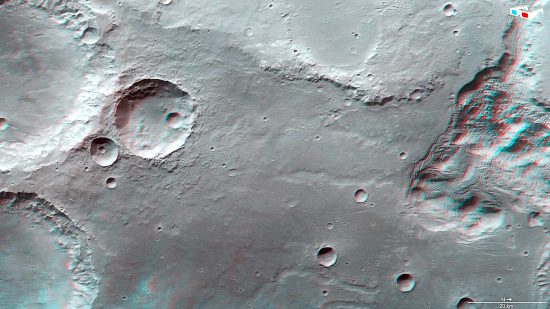
November 20, 2020
Water features?
A recent Picture of the Day discussed what planetary scientists referred to as fossilized mineral springs on Mars. The structures were compared by NASA to dried-up Australian geological features, suggesting that they both are born of similar circumstances.
In the image at the top of the page, the anaglyph helps to illustrate how a large chunk of the Martian landscape has, apparently, “collapsed” because the water and ice that supported it drained away. That is how the European Space Agency sees it.
The largest crater in the upper left is about 40 kilometers in diameter, with fractures and fissures that are conventionally thought to form after impact, when the molten rock cooled and contracted. Almost everything to the left in this image is thought to be due to molten rock and explosions.
On the right is what Mars investigators call “chaos”, or “chaotic terrain”. As the label implies, it is irregular and “jumbled”, because it was formed by the subsidence of chasms and caverns that were once filled with water ice. The ice melted in response to the heat generated by (presumed) multiple impact scenarios.
Ice is not directly observed by the research team. The shape of the topography, particularly the fractured blocks and elevation drop, lead them to conclude that massive amounts of water-ice might be found on Mars. In the 3D anaglyph image at the top of the page, bizarre polygonal structures, thousands of parallel “cracks”, and multiple terraces are clearly visible. The fractured areas are not the signs of ice and water, they are the signs of electric arcs.
Mars was once the scene of powerful electric arcs that carved the planet’s surface. The energy released by plasma discharges took the form of sinuous rilles, flat-floored craters, “railroad track” patterns in canyons and craters, intersecting gullies with no debris inside them, giant mesas with Lichtenberg “whiskers” and steep-sided ravines wending through landscapes dotted with circular uplifts.
If Mars was the scene of planetary lightning bolts and not ice moving across the surface, should similar observations on Earth be reconsidered?
Stephen Smith












